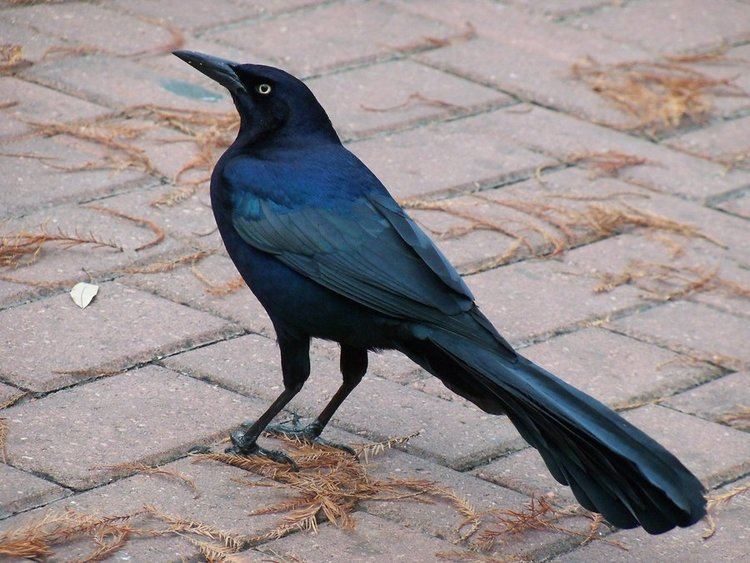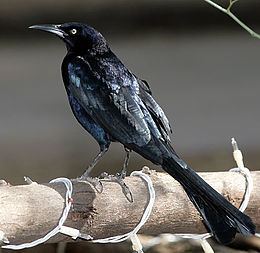Order Passeriformes | Phylum Chordata Scientific name Quiscalus mexicanus Rank Species | |
 | ||
Similar Bird, Quiscalus, Common grackle, Boat‑tailed grackle, Brewer's blackbird | ||
Great tailed grackles in houston
The great-tailed grackle or Mexican grackle (Quiscalus mexicanus) is a medium-sized, highly social passerine bird native to North and South America. A member of the family Icteridae, it is one of ten extant species of grackle and is closely related to the boat-tailed grackle and the slender-billed grackle. It is sometimes erroneously referred to as a "blackbird" in the southern United States, although blackbirds belong to the genus Euphagus. Similarly, it is often called "cuervo" in areas of Mexico owing to its glossy black plumage, although it is not a member of the genus Corvus, nor even of the family Corvidae.
Contents
- Great tailed grackles in houston
- Mating dance of the great tailed grackle
- Description
- Distribution and habitat
- Diet
- Behavior
- In culture
- References

Mating dance of the great tailed grackle
Description

Great-tailed grackles are medium-sized birds (larger than starlings and smaller than crows; 38 cm (15 in)-46 cm (18 in)) with males weighing 203 g (7.2 oz)-265 g (9.3 oz) and females between 115 g (4.1 oz)-142 g (5.0 oz), and both sexes have long tails. Males are iridescent black with a purple-blue sheen on the feathers of the head and upper body, while females are brown with darker wings and tail. Adults of both sexes have bright yellow eyes, while juveniles of both sexes have brown eyes and brown plumage like females (except for streaks on the breast). Great-tailed grackles, particularly the adult males, have a keel-shaped tail that they can fold vertically by aligning the two halves.

The great-tailed grackle and boat-tailed grackle were considered the same species until genetic analyses distinguished them as two separate species.
Distribution and habitat

Originally from Central and South America, great-tailed grackles expanded their breeding range by over 5500% by moving north into North America between 1880 and 2000, following urban and agricultural corridors. Their current range stretches from northwest Venezuela and western Colombia and Ecuador in the south to Minnesota in the north, to Oregon, Idaho, and California in the west, to Louisiana in the east, with vagrants occurring as far north as southern Canada. Their habitat for foraging is on the ground in clear areas such as pastures, wetlands and mangroves.
Diet

Great-tailed grackles are noted for their diverse foraging habits. They extract larvae and insects from grassy areas; eat lizards, nestlings, and eggs; forage in freshly plowed land; remove parasites from cattle; and eat fruits (e.g., bananas, berries) and grains (e.g., maize, corn on the cob by opening the husks). They turn over objects to search for food underneath, including crustaceans, insects, and worms, they hunt tadpoles and fish by wading into shallow water, and although they do not swim, they catch fish by flying close to the water's surface, and are even reported to dive a few inches into the water to retrieve a fish. They are also known to pick dead insects off the license plates of parked cars, and kill barn swallows while flying.
Behavior
Great-tailed grackles have an unusually large repertoire of vocalizations that are used year-round. Males use a wider variety of vocalization types, while females engage mostly in "chatter", however there is a report of a female performing the "territorial song". Because of their loud vocalizations, great-tailed grackles are considered a pest species by some.
They communally roost in trees or the reeds of wetlands at night and, during the breeding season, they nest in territories using three different mating strategies: 1) territorial males defend their territory on which many females place their nests and raise young, 2) residential males live in the larger colony but do not defend a territory or have mates, and 3) transient males stay for a few days before leaving the colony to likely move onto another colony. Resident and transient males sire a small number of offspring through extra pair copulations with females on territories. Territorial males are heavier and have longer tails than non-territorial males, and both of these characteristics are associated with having more offspring.
Grackles can solve Aesop's Fable tests - a problem involving a tube that is partially filled with water and a floating out of reach piece of food. The problem is solved by dropping objects into the water to raise the level and bring the food within reach. They are also behaviorally flexible, changing their preferences quickly in response to changes in cognitive tasks.
In culture
In Mexico, where it is known as the chanate or zanate, there is a legend that it has seven songs. "In the creation, the Zanate having no voice, stole its seven distinct songs from the wise and knowing sea turtle. You can now hear the Zanate's vocals as the Seven Passions (Love, Hate, Fear, Courage, Joy, Sadness, and Anger) of life." Mexican artisans have created icons in clay, sometimes as whistles that portray the sea turtle with the zanate perched on its back.
In Colombia, the species is called Maria mulata, and is the official bird of Cartagena de Indias. Cartagena artist, Enrique Grau, had an affinity for these birds and because of his inspiration many Colombian monuments and artistic works were created in honor of its intelligence, adaptability, cheerfulness, sociability and collaborative tendencies, diligence, craftiness, and ability to take advantage of adversity.
In Austin, Texas, it is commonly found congregating near the city's numerous food trucks.
